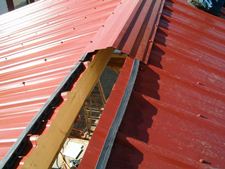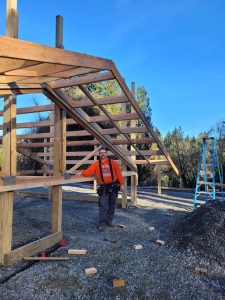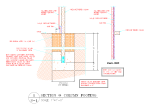Welcome to Ask the Pole Barn Guru – where you can ask questions about building topics, with answers posted on Mondays. With many questions to answer, please be patient to watch for yours to come up on a future Monday segment. If you want a quick answer, please be sure to answer with a “reply-able” email address.
Email all questions to: PoleBarnGuru@HansenPoleBuildings.com
DEAR POLE BARN GURU: Looking at a 40×60 pole barn on my 80 acre property. Weighing all the usual options, but the biggest issue that I have is the site. There is a couple degree down-hill pitch towards the site that the building will be built. Traditionally, we would put in a frost wall foundation, high enough so that the swale could divert any runoff around the building. Given I’m much more inclined to go with a pole barn at this site, what can I do to get the building up off the ground high enough to avert any natural pole building drainage from running under the barn?
I am used to traditional foundation/stick framing, but not sure about sub-foundation planning for pole barns.
Thanks for helping! LIGHTENING IN GOOD THUNDER
DEAR LIGHTENING: Assuming this is not going to be used as a home (in which case I would make entirely different recommendations using a raised wood floor), I’d approach this as for any pole building drainage solution. I would order columns long enough to get the required depth to extend below the frost line, plus make up for any grade change. After the columns were set, I’d bring in fill to get the elevation of the bottom of any future concrete slab above the highest point of the surrounding grade. Above the high side of the building, a French drain can be installed to divert any natural drainage.
For those who are not familiar with the term – a French drain is when you dig a trench and then put some drain rock in the bottom of it. Then lay in one or more rows of perforated 4 inch pipe and fill the rest of the trench with drain rock.
DEAR POLE BARN GURU: Looking around on your website, I seem to be unable to find the dimensions and wood species, and shape of the poles that come with your buildings. Help? FREAKYALIENBABY
DEAR ALIEN: There are many variables which are going to influence the answers to your question. One of those is going to be geography – where the building will be constructed.
The other is, what loads will need to be supported by the columns. As wind and/or snow loads increase, so will the size of the columns. Whether it’s enclosed or “roof only” makes a huge difference, as well as eave heights over 16’. I mention only a few of the variables here as examples.
As to dimensions, we use 4×6, 5×6 (In some parts of the country 4×6 and 6×6 are not available, but 5×6 is), 6×6, 6×8, 6×10.
In the East and Midwest, the species with be SYP (Southern Yellow Pine); in the west HFir (Hem-Fir).
We also use glu-laminated columns, anything from 3 ply 2×6 to 4 ply 2×8 and larger.
The shape? Not round – these are not fence posts nor telephone poles. They will be square (if 6×6) or rectangle if dimensions are not equal on both sides.
If you decide you want certain size columns – because it makes you “feel like it’s sturdier”, that’s fine, as long as they meet code. For example – we’ve had folks request “all 6×6’s” even though they don’t understand under certain conditions a 4×6 will outperform a 6×6, and going to a 6×6 gave them no added “strength” to their building. They basically paid for larger columns – for no added value. But that’s a topic for another blog. Once you get a quote and are ready to purchase, we can give you a pretty good idea of what size columns will be used on the building you plan to purchase – according to the loads applied to it – and the size. Hope this helps!
DEAR POLE BARN GURU: Who do I go to to get the information regarding my proposed building’s Code requirements for wind and snow? Would code enforcement have it? MEANDERING IN MAINE
DEAR MEANDERING: Typically most jurisdictions have a department such as : “Building”, “Community Development”, etc. – they are the department you would need to go to in order to acquire a permit to build.
If unable to easily determine: if you are in the city limits, call city hall. If outside of city limits, call the county courthouse. Ask either who you would need to speak with to obtain a building permit.
DEAR POLE BARN GURU: I am pricing post frame building. One mfg uses 26 ga steel while another uses 29 ga. Which is better when not considering price? Is tensile strength a big consideration? HIKING IN FROM HERON LAKE
DEAR HIKING: I suppose the real question to be asked is, do you NEED 26 gauge steel?
This article answers lots of questions about steel thickness:
https://www.hansenpolebuildings.com/blog/2012/01/steel-thickness/
Tensile strength is a consideration, as it will directly affect the strength and spanning capabilities of the steel. To the best of my knowledge, all of the major steel roll forming companies are manufacturing 29 gauge product with an 80,000 psi minimum tensile strength. There is a company which is providing 26 gauge product which is softer, it has a lower yield point. This allows for the steel coil to be roll formed into siding on machine with fewer dies stages, which reduces the investment needed into the machine. Although their steel panels are thicker, they won’t span any further, as the steel is not as strong.
DEAR POLE BARN GURU: I have read dozens of different opinions, many contradicting each other, on condensation. I have built a monitor style pole barn 44×40 with a 20′ raised center isle. Will have a 20×20 loft that will be finished and insulated. The rest will be open shop space. I have the trusses on 48″ centers with 2×4 purlins laid flat on 24″ centers. I need to know what will be the best underlayment to put between the metal and purlins. I was looking at solid attic foil, that is basically, a vapor brainier and radiant barrier, with no insulation. But I saw an article that said that it would still condensate on the bottom of the attic foil. I will be using 26ga galvalume screw down panels, and I am in north Louisiana. LOOKING IN LOUISIANA
DEAR LOOKING: Easiest solution is to place reflective insulation, like an A1V product between the roof purlins and the roof steel (see www.buyreflectiveinsulation.com).
Other important things to do – make sure to place a good vapor barrier under your concrete slab. https://www.hansenpolebuildings.com/blog/2012/09/concrete-slab-3/
You also need to have proper ventilation – with good intakes at the eaves from vented soffits, as well as a vented ridge. https://www.hansenpolebuildings.com/blog/2014/02/pole-building-ventilation/









